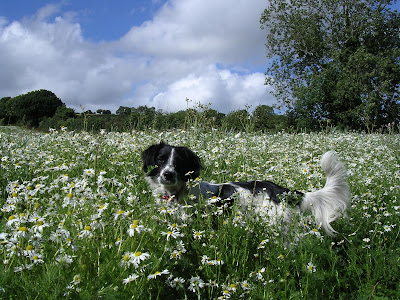 |
| My eyrie |
Seaton – which we hadn’t visited for 42 years – turned out to be a pleasant, quiet town in a wide bay with stunning white cliffs.
 |
| Seaton |
Tourism was low key but lots of people milled around and the vegan café had no space for us. We found somewhere else and sat in the baking sun eating prawn sandwiches (me) and a tuna and cheese panini (Frog). A long way from vegan, but jolly nice. A man on the esplanade sang songs from musicals to original backing tracks. ‘Feed the birds . . . Tuppence a bag . . . ’ Ellie hoovered up crisp fragments under our feet and tried to make friends with everybody who walked past. One of the waitresses gave her a biscuit and we could see Ellie adding Seaton to her mental list of Places She Liked (Glastonbury being another).
The route to the coast path took us up a steep but thankfully shady lane and then through a golf course, which wasn’t on my map. Walkers were tolerated so long as they kept to the designated route which was, I presumed, the old footpath. Small pockets of rough grass . . .
.
. . and I silently mourned what the hillside must once have been. Why would you
pay £25 for a round of golf when you could walk for nothing? (Joni Mitchell
would agree with me.*)
We reached a proper footpath and then we saw this.
This was more like it, I thought. Frog looked slightly green.
Even though Devon didn’t change to Dorset until you got to Lyme Regis, the soil - as the white cliffs indicated - was now chalky rather than red sandstone and the landscape was completely different - drier, greyer, less lush. I felt as if I was in a different country.
There
were few wildflowers around. Just this Old Man’s Beard (a wild Clematis) which
likes chalky soil . . .
 |
| Old Man's Beard |
.
. . and this lovely (Small?) Scabious, another chalk plant.
 |
| Scabious |
 |
Scabious (and bee), to try and show you the size of the flower, which is about 3/4 inch diameter |
. . . and strict exhortations to Keep to the Waymarked Route.
It said that the next five miles took most people at least 3 1/2 hours to complete, repeated the information that there was no way out either inland or down to the sea and added that there was no mobile-phone reception either.
So far we’d met one other walker but he was too serious to stop and talk, and a runner who was too exhausted to do more than nod his head in our direction. We wondered if they’d come all the way from Lyme Regis. No doubt we appeared to them like rank amateurs, Frog in his sandals and me in my sneakers.
This stretch of the coast path was starting to feel like one of those rites of passage like crossing the Nullabor Plain in Australia (when I went there in 1975) or the Camino de Santiago, the Spanish pilgrimage Frog’s brother had done.
*'Big Yellow Taxi'








































